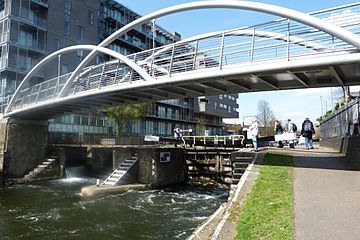Salmon Lane Lock facts for kids

Salmon Lane Lock
|
|
| Waterway | Regent's Canal |
|---|---|
| County | Tower Hamlets Greater London |
| Maintained by | Canal and River Trust |
| Fall | 8 feet (2.4 m) |
| Distance to Limehouse Basin |
0.4 miles (0.6 km) |
| Distance to Paddington Basin |
8.5 miles (13.7 km) |
| Coordinates | 51°30′54″N 0°02′05″W / 51.514905°N 0.034838°W |
Salmon Lane Lock is a special part of the Regent's Canal in Limehouse, a busy area in the London Borough of Tower Hamlets in London. This lock helps boats travel along the canal by changing their water level. A new bridge was built here in February 2005, making it easier for people to cross the canal and connect Parnham Street to Salmon Lane.
Contents
What is a Canal Lock?
A canal lock is like a water elevator for boats. It's a chamber with gates at both ends. Locks are needed when a canal needs to go up or down a hill. Without locks, canals would have to be perfectly flat, which is very hard to build.
How a Lock Works
When a boat wants to go up, it enters the lock. The bottom gate closes behind it. Water is then let into the chamber from the higher part of the canal. As the water fills up, the boat rises. Once the water level inside the lock matches the higher canal, the top gate opens, and the boat can leave.
If a boat wants to go down, the process is the opposite. The boat enters, the top gate closes, and water is let out of the chamber into the lower part of the canal. The boat slowly lowers with the water. When the water level matches the lower canal, the bottom gate opens, and the boat can continue its journey.
Salmon Lane Lock in Action
Salmon Lane Lock works just like this. It helps boats move between different water levels on the Regent's Canal. This lock is managed by the Canal & River Trust, who look after many canals and rivers in England and Wales. They make sure the locks are working well and safe for everyone to use.
The Regent's Canal
The Regent's Canal is a famous waterway that runs through the heart of London. It stretches for about 8.5 miles (13.7 kilometers) from Paddington Basin in the west to Limehouse Basin in the east. Salmon Lane Lock is located very close to the eastern end of the canal, near Limehouse Basin.
History of the Canal
The Regent's Canal was built a long time ago, in the early 1800s. It was finished in 1820. Its main purpose was to transport goods like coal, timber, and food across London. This was before trains and trucks were common. Boats, called barges, would carry heavy loads along the canal, helping businesses grow and people get the things they needed.
The Canal Today
Today, the Regent's Canal is no longer used much for carrying goods. Instead, it's a popular place for leisure and fun. Many people enjoy walking or cycling along the towpaths next to the water. You can also see narrowboats, which are long, thin boats, cruising along the canal. Some people even live on these boats! The canal is also home to lots of wildlife, including ducks, swans, and fish.

